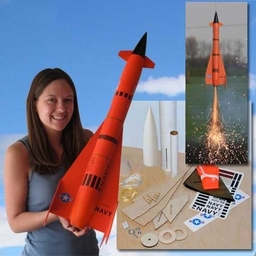   |
| Rating | |
| Length | 30.75" 78.11cm |
| Diameter | 2.60" 6.60cm |
| Weight | 1.19lbs 0.54kg |
| Parachute | 30" 76.20cm |
| Drogue | |
| Motor Mount | 29mm |
| Deployment | Single |
Jay Hawk AQM-37A-2.6"
File

 jayhawk.rkt.zip
jayhawk.rkt.zip 
 jayhawk.pdf
jayhawk.pdf Description
Features:
Durable Plastic Cone
Water Slide Decal Sheet
Balsa Tail Cone
Flameproof Chute Protector
Laser Cut Plywood Parts
Kevlar/Nylon Shock Cord
Heavy Duty Body Tube
Specifications:
Length: 30.75"
Diameter: 2.6"
Weight: 19oz
Recovery: 30" Nylon Chute
Motor Mount: 29mm
Fins: 1/8" Plywood
History
In the 1959, the US Navy and US Air Force issued a joint request for a new high-speed expendable target. Beechcraft won the competition, and the result was a small delta-winged drone with wingtip fins and a liquid rocket motor, originally designated XKD2B-1 but now known as the AQM-37. The type first flew in May 1961, entered service with the US Navy in 1963, and remains in service.
The original version was the AQM-37A or Beech Model 1019. The AQM-37A was followed by a confusing list of subvariants, some of which were new production, others which were modifications of existing AQM-37s. These variants were intended to simulate different classes of threats, such as sea-skimming antiship missiles or high-altitude naval attack missiles, or provide better performance. One high-performance variant with improved thermal protection attained a speed of Mach 4.7 and an altitude of over 112,000 feet (34 kilometers) on a ballistic trajectory. The final US Navy variant was designated AQM-37C.
More than 5,000 AQM-37 targets of all variants have been delivered since the early 1960s. The AQM-37C/D is still in limited production for the U.S. Navy.















